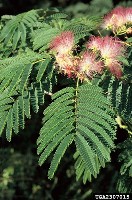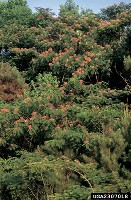Written by D.J. Moorhead and G.K. Douce for Forest Encyclopedia Network
A mimosa infestation favors disturbed sites, where they can grow quickly and prevent native plant establishment.
Mimosa, also known as silk tree, is a small deciduous tree that is 10 to 50 feet in height, often having multiple trunks. It has delicate looking bi-pinnately compound leaves that resemble ferns (Miller 2003). The bark is smooth and light tan to greenish in color. Mimosa has very showy, pink, fragrant flowers which start blooming in late spring and persist into summer (Fig. 1). The flowers give way to small, flat bean-pod like fruits.
Mimosa is native to Asia and was first introduced into the U.S. in 1745 as an ornamental. It is widespread throughout the southern Appalachians at elevations below 3000 ft. (SE-EEPC 2003). Mimosa invades any type of disturbed habitat. It is commonly found in old fields, stream banks, pastures, fence lines, and roadsides (Fig. 2). It can tolerate partial shade but does not grow well under a forest canopy. It can form large colonies from root sprouts which can dominate disturbed sites and quickly close in open areas. The seeds, which are produced in abundance, are dispersed by animals and water, allowing this plant to quickly spread and invade new areas. Once established, mimosa is difficult to remove due to the long lived seeds and its ability to re-sprout vigorously.
Adapted for eXtension.org by Thomas DeGomez, University of Arizona
References Cited
Miller, J.H. 2003. In: Nonnative invasive plants of southern forests: a field guide for identification and control. Asheville, NC: U.S.Department of Agriculture, Forest Service,Southern Research Station: 93p.
SE-EPPC. 2003. Southeast Exotic Pest Plant Council Invasive Plant Manual.
External Links
Related to Mimosa:
- Invasive Species and Biodiversity
- Invasive Forest Plants
- Invasive Species and Climate
- Diversity in the Forest Understory


